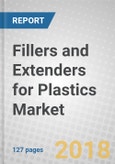Report Scope:
In this report, the market has been segmented based on application, end-user industry, type and region. It covers the overview of the global market for plastic fillers and extenders and analyses of global market trends, considering base year of 2016 and estimates for 2017 to 2022. Revenue forecasts from 2017 to 2022 are given for each type, application, end-user industry and region market with estimated values derived from manufacturers’ total revenues. Throughout the report, inorganic plastics fillers are considered owing to their major acceptance in the plastics fillers and extenders market.
The report also includes a discussion of the major players in the market. Further, it explains the major drivers and regional dynamics of the plastic fillers and extenders and current trends within the industry. The report concludes special focus on the vendor landscape and includes detailed profiles of the major vendors in the global plastic fillers and extenders market.
Report Includes:
- An overview of the global markets for fillers and extenders for plastics
- Analyses of global market trends, with data from 2016 and 2017, and projections of compound annual growth rates (CAGRs) through 2022
- Analysis of the market dynamics and industry structure
- In-depth analysis of the market’s growth factors, specifically globalization and intermaterial competitive trends
- Comprehensive company profiles of major players in the market, including Evonik Industries AG, Hoffmann Mineral Gmbh, LKAB Minerals, Omya AG and Unimin Corp
Summary:
Plastic fillers and extenders are types of plastic additives primarily used to bulk up the plastic, reduce cost and enhance properties such as stiffness, dimensional stability, weathering, surface smoothness and temperature resistance. Fillers and extenders are used to decrease the consumption of expensive binder material and to enhance the properties of plastic. Plastic fillers and extenders improve the performance of plastics in a way that cannot be achieved by other resin ingredients and reinforcement materials alone. Plastic fillers and extenders are also used to improve processing, mechanical and physical properties such as stiffness, hardness, and thermal insulation. In plastics, there are two types of fillers and extenders used to improve the performance of products: inert fillers and active fillers. Inert fillers are also referred to as bulk fillers and are used to reduce cost by decreasing the amount of plastic resin used. Inactive fillers and extenders are used to improve physical and mechanical properties such as strength, hardness, thermal stability, chemical resistance and appearance.
Fillers and extenders are blended into a polymer melt or mixture to extend the volume. Since fillers are often inexpensive inorganic chemicals such as calcium carbonate, they cost less than plastic resins. Adding fillers can reduce the cost of the compound if adding the filler does not significantly reduce the properties of the plastics compound. In some cases, a filler can also improve properties and performance, in the same way, that foaming plastics produce better products at lower cost. In this case, the filler is also a reinforcement.
When compared to other additives and plastic resins, fillers and extenders are the least expensive ingredients to reinforce plastics. In plastic parts, filled resins shrink less than unfilled resins, so the addition improves the dimensional control of molded parts.
Plastic fillers and extenders are of two types, organic and inorganic. Organic fillers and extenders contain organic and natural particulates and solid fibers that can be acicular, fibrous irregular, or flakey and are used in plastics such as thermoplastics. Tree bark flour, cottonseed hulls, kenaf flour, rice hull flour, soy bean flour, rice hull grit and wheat chaff are some of the organic fillers used in plastics. Mineral fillers are a sub category of inorganic filler and are comprised of ground rocks, and refined, natural and synthetic minerals. Calcium carbonate, kaolin, dolomite, silicates, mica, carbon black and talc are examples of inorganic mineral fillers. In this report, only inorganic mineral fillers are considered. They are used predominantly due to cost and performance benefit.
Some of the most commonly used plastic fillers are:
Carbon black: A common extender used in rubbers derived from synthetic elastomers to produce wear resistant and strong products. Carbon black extenders are mixed with polymers in several ways, such as impregnation with polymer solutions and melts or mixing in a roller mill.
Calcium carbonate: The most widely used inorganic filler, Common grades of calcium carbonate filler are extracted from marble and limestone and are usually used in automobile plastic parts. It is available in a variety of particle sizes and at a lower cost compared to other inorganic fillers.
Membership Price:
Contact us for membership pricing.
Table of Contents
Companies Mentioned
- Hoffmann Mineral Gmbh
- Imerys
- J.M. Huber Corporation
- Lkab Minerals
- Minerals Technologies, Inc.
- Omya AG
- Unimin Corporation




![Conductive Filler Market: Trends, Opportunities and Competitive Analysis [2024-2030] - Product Image](http://www.researchandmarkets.com/product_images/12371/12371622_60px_jpg/conductive_filler_market.jpg)



